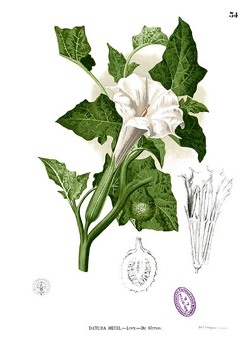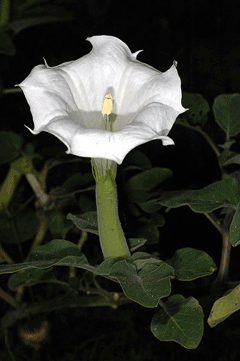 |
|
http://commons.wikimedia.org/wiki/File:Datura_metel_Blanco1.34.jpg |
 |
| http://www.flickr.com/people/20087733@N00 |
Translate this page:
Summary
Physical Characteristics

 Datura inoxia is a ANNUAL growing to 1 m (3ft 3in).
Datura inoxia is a ANNUAL growing to 1 m (3ft 3in).
See above for USDA hardiness. It is hardy to UK zone 9 and is frost tender. The species is hermaphrodite (has both male and female organs) and is pollinated by Insects.
Suitable for: light (sandy) and medium (loamy) soils and prefers well-drained soil. Suitable pH: neutral and basic (mildly alkaline) soils and can grow in very alkaline soils.
It cannot grow in the shade. It prefers dry or moist soil.
UK Hardiness Map
US Hardiness Map
Synonyms
D. meteloides. DC.
Plant Habitats
Cultivated Beds;
Edible Uses
Edible Parts: Fruit
Edible Uses: Drink
Fruit - ground up and mixed with clay[161] ( the clay probably has a neutralizing effect on the toxins). A very toxic plant, its use as a food cannot be recommended[K]. The fruit is up to 5cm long and 7cm wide[200]. A stupefying beverage is made from the leaves and roots[161].
References More on Edible Uses
Medicinal Uses
Plants For A Future can not take any responsibility for any adverse effects from the use of plants. Always seek advice from a professional before using a plant medicinally.
Anodyne Antispasmodic Hallucinogenic Hypnotic Narcotic
All parts of the plant are anodyne, antispasmodic, hallucinogenic, hypnotic and narcotic[192, 240]. It has been used in the past as a pain killer and also in the treatment of insanity, fevers with catarrh, diarrhoea and skin diseases[240]. The plant contains several alkaloids, the most active of which is scopolamine[240]. This is a potent cholinergic-blocking hallucinogen, which has been used to calm schizoid patients[213]. The leaves contain 0.52% scopolamine, the calices 1.08%, the stems 0.3%, the roots 0.39%, the fruits 0.77%, the capsules 0.33%, the seeds 0.44% and the whole plant 0.52 - 0.62%[240]. Any use of this plant should be with extreme caution and under the supervision of a qualified practitioner since the toxic dose is very close to the medicinal dose.
References More on Medicinal Uses
The Bookshop: Edible Plant Books
Our Latest books on Perennial Plants For Food Forests and Permaculture Gardens in paperback or digital formats.

Edible Tropical Plants
Food Forest Plants for Hotter Conditions: 250+ Plants For Tropical Food Forests & Permaculture Gardens.
More

Edible Temperate Plants
Plants for Your Food Forest: 500 Plants for Temperate Food Forests & Permaculture Gardens.
More

More Books
PFAF have eight books available in paperback and digital formats. Browse the shop for more information.
Shop Now
Other Uses
Planted throughout the world as an ornamental plant for its attractive large leaves, large white flowers, and distinctive thorny fruit. However, the plant is now considered an invasive species in several locations.
Special Uses
References More on Other Uses
Cultivation details
Prefers a rich light sandy soil[1] and an open sunny position[200]. It is best grown in a fertile calcareous soil[200]. Plants are not very cold-hardy, tolerating temperatures down to about -5°c[260]. Plants can be grown outdoors as half-hardy annuals, starting the seed off in a greenhouse. This species is extremely susceptible to the various viruses that afflict the potato family (Solanaceae), it can act as a centre of infection so should not be grown near potatoes or tomatoes[200]. This species is a commercial source of the alkaloid scopolamine, used in the pharmaceutical industry[240].
References Carbon Farming Information and Carbon Sequestration Information
Temperature Converter
Type a value in the Celsius field to convert the value to Fahrenheit:
Fahrenheit:
The PFAF Bookshop
Plants For A Future have a number of books available in paperback and digital form. Book titles include Edible Plants, Edible Perennials, Edible Trees,Edible Shrubs, Woodland Gardening, and Temperate Food Forest Plants. Our new book is Food Forest Plants For Hotter Conditions (Tropical and Sub-Tropical).
Shop Now
Plant Propagation
Sow the seed in individual pots in early spring in a greenhouse[200]. Put 3 or 4 seeds in each pot and thin if necessary to the best plant. The seed usually germinates in 3 - 6 weeks at 15°c. Plant out in late spring or early summer, after the last expected frosts. Especially in areas with hot summers, it is worthwhile trying a sowing outdoors in situ in mid to late spring.
Other Names
If available other names are mentioned here
angel's trumpet; hoary thorn-apple; Indian-apple; moonapple; sacred datura; thorn-apple. Spanish: cacaito. French: datura innocente. Arabic: datura; tatoora. Australia: downy thorn-apple; recurved thorn-apple. Brazil: datura-européia; trombeta-branca; trombeteira-branca. China: mao man tuo luo. Korea, Republic of: teoldogmalpul. Mexico: toloache. South Africa: harige stinkblaar. Sweden: mexikansk spikklubba. USA: pricklyburr.
Native Range
NORTHERN AMERICA: United States (Texas), Mexico (Baja California (Norte), Baja California Sur, Chihuahua, Coahuila de Zaragoza, Durango, Nuevo León, San Luis Potosí, Sinaloa, Sonora, Tamaulipas, Zacatecas, Aguascalientes, Campeche, Chiapas, Colima, Guanajuato, Guerrero, Hidalgo, Jalisco, México, Michoacán de Ocampo, Morelos, Nayarit, Oaxaca, Puebla, Querétaro, Quintana Roo, Veracruz de Ignacio de la Llave, Yucatán) SOUTHERN AMERICA: Hispaniola (natzd.?), Anguilla (natzd.?), Antigua and Barbuda (Antigua (natzd.?)), Bahamas (natzd.?), Barbados (natzd.?), Cuba (natzd.?), Guadeloupe (natzd.?), Jamaica (natzd.?), Martinique (natzd.?), United States (Puerto Rico (natzd.?)), St. Vincent and Grenadines (natzd.?), Guatemala, Honduras, Venezuela, Bolivia, Colombia, Ecuador, Peru, Paraguay
Weed Potential
Right plant wrong place. We are currently updating this section.
Please note that a plant may be invasive in one area but may not in your area so it's worth checking.
Invasive in the Galapagos islands, New Caledonia, mainland China and Taiwan, and in South Africa and Namibia. It is widely naturalized in the tropics and increasingly in temperate Europe and North America. D. innoxia has been listed as a Declared Weed in South Africa which is prohibited and must be controlled [1d]
Conservation Status
IUCN Red List of Threatened Plants Status : This taxon has not yet been assessed.

Growth: S = slow M = medium F = fast. Soil: L = light (sandy) M = medium H = heavy (clay). pH: A = acid N = neutral B = basic (alkaline). Shade: F = full shade S = semi-shade N = no shade. Moisture: D = dry M = Moist We = wet Wa = water.
Now available:
Food Forest Plants for Mediterranean Conditions
350+ Perennial Plants For Mediterranean and Drier Food Forests and Permaculture Gardens.
[Paperback and eBook]
This is the third in Plants For A Future's series of plant guides for food forests tailored to
specific climate zones. Following volumes on temperate and tropical ecosystems, this book focuses
on species suited to Mediterranean conditions—regions with hot, dry summers and cool, wet winters,
often facing the added challenge of climate change.
Read More
Expert comment
Author
Mill.
Botanical References
71200
Links / References
For a list of references used on this page please go here
Readers comment